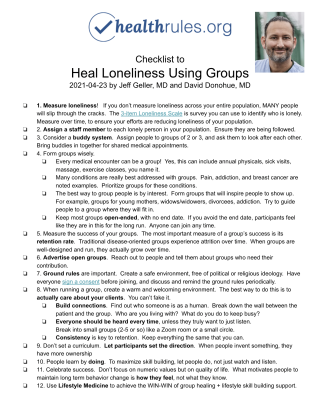The Checklist
If your goal is to...
Social isolation worsens our health. Loneliness kills. People who are lonely have a 1.29 to 2.8 fold increased risk of death in a given year. It varies by gender and race, with African American men facing the gravest consequences when socially isolated (2.3 fold increased risk of death) and white mean suffering the least (a very serious 1.6 fold risk of death).
By our nature, humans need social connection. When deprived of social connection, our bodies react with stress, inflammation, impaired immunity, depression, and a host of other disabilities. Many of us are lonely during at least periods of our lives. Situational loneliness can appear with many situations like job loss, end of a relationship, death of a loved one, receiving a new diagnosis. Some of us are lonely for decades.
When we heal loneliness, we improve people's health. People are less likely to go to the hospital or incur expensive medical bills. People are less likely to need medicines for blood pressure or diabetes. People live longer! And happier!
What can the health care system do to help? One thing we can do is to help fill the void in people's lives by creating a "medical home" for people. Many doctors think it is not their job to "bullsh*t with patients", but in many cases this connection is the medicine that patients need.
Part of creating a medical home is to give people a way to congregate in a safe, health promoting setting. The medical group visit is a powerful way to bring groups of patients/clients together, to collectively achieve deeper connection, health education, and healthy skill building.
When done properly, groups can be so powerful that they are beneficial irrespective of the educational material that is presented. Dr. Jeff Geller coined the term the Group Inclusion Effect, akin to the placebo effect, meaning that the mere inclusion of a person in a group program will create an expected benefit in outcomes, regardless of what the group discusses.
Checklist to Heal Loneliness Using Groups
- 1. Measure loneliness! If you don’t measure loneliness across your entire population, MANY people will slip through the cracks. Lonely people often put on a good show and do not let on how lonely they really are. The 3-item Loneliness Scale is quick and convenient survey you can use to measure loneliness. Measure over time, to ensure your efforts are reducing loneliness of your population.
- 2. Assign a staff member to each lonely person in your population. Ensure they are being followed on an appropriate basis.
- 3. Consider a buddy system. Assign people to groups of 2 or 3, and ask them to look after each other. Bring buddies in together for shared medical appointments.
- 4. Form groups wisely.
- Every medical encounter can be a group! Yes, this can include annual physicals, sick visits, massage, exercise classes, you name it.
- Many conditions are really best addressed with groups. Pain, addiction, and breast cancer are noted examples. Prioritize groups for these conditions.
- The best way to group people is by interest. Form groups that will inspire people to show up. For example, groups for young mothers, widows/widowers, divorcees, addiction. Try to guide people to a group where they will fit in.
- Keep most groups open-ended, with no end date. If you avoid the end date, participants feel like they are in this for the long run. Anyone can join any time. Like camp. You can use closed group when you need more of a curriculum or more private groups.
- 5. Measure the success of your groups. The most important measure of a group’s success is its retention rate. Traditional disease-oriented groups experience attrition over time. When groups are well-designed and run, they actually grow over time.
- 6. Advertise open groups. Reach out to people and tell them about groups that you think need their contribution.
- 7. Ground rules are important. Create a safe environment, free of political or religious ideology. Have everyone sign a consent before the group, and discuss and remind the ground rules periodically.
- 8. When running a group, create a warm and welcoming environment. The best way to do this is to actually care about your clients. You can’t fake it.
- Build connections between people. Find out who someone is as a human. Break down the wall between the patient and the group. Who are you living with? What do you do to keep busy?
- Everyone should be heard every time, unless they truly want to just listen.
Break into small groups (2-5 or so) like a Zoom room or a small circle. - Consistency is key to retention. Keep everything the same that you can. Same time, same location, same facilitators, same structure.
- 9. Don’t set a curriculum. Let patients set the direction. When people invent something, they have more ownership
- 10. People learn by doing. To maximize skill building, let people do, not just watch and listen.
- 11. Celebrate success. Don’t focus on numeric values but on quality of life. What motivates people to maintain long term behavior change is how they feel, not what they know.
- 12. In your groups, use Lifestyle Medicine to achieve the WIN-WIN of group healing + health lifestyle skill building & support.
Podcast
Listen to a podcast about this checklist
Contributors

Jeff Geller, MD
Jeff Geller is a family physician and an integrative medicine physician. He is a nationally recognized expert in group medical visits, and founder of the Integrated Center for Group Medical Visits. He was the 2020 Massachusetts Family Physician of the year.

David Donohue, MD MS FACP DipABLM @WellDrDave
Dave is the creator of healthrules.org and helped build this checklist. He is a primary care internist, fellow of the American College of Physicians, and a diplomate of the American Board of Lifestyle Medicine.
Handout

References
Kassandra I Alcaraz, Katherine S Eddens, Jennifer L Blase, W Ryan Diver, Alpa V Patel, Lauren R Teras, Victoria L Stevens, Eric J Jacobs, Susan M Gapstur. Social Isolation and Mortality in US Black and White Men and Women. American Journal of Epidemiology, 2018; DOI: 10.1093/aje/kwy231
Holt-Lunstad J, Smith TB, Baker M, et al. Loneliness and social isolation as risk factors for mortality: a meta-analytic review. Perspect Psychol Sci. 2015;10(2):227–237.
Russell, D , Peplau, L. A.. & Ferguson, M. L. (1978). Developing a measure of loneliness. Journal of Personality Assessment, 42, 290-294.
Hughes ME, Waite LJ, Hawkley LC, Cacioppo JT. A Short Scale for Measuring Loneliness in Large Surveys: Results From Two Population-Based Studies. Res Aging. 2004;26(6):655-672. doi: 10.1177/0164027504268574. PMID: 18504506; PMCID: PMC2394670.
Jeffrey S. Geller. The Journal of Alternative and Complementary Medicine.Jul 2019.673-674.http://doi.org/10.1089/acm.2019.0012
Jeffrey S. Geller, Eileen T. Dube, Jeffrey Kowaleski. Establishing and Maintaining Successful Chronic Pain Group Medical Visits Using an Empowerment Model, Integrated Center For Group Medical Visits
Paula Gardiner, Maria Chao, and Marena Burnett.The Journal of Alternative and Complementary Medicine.Jul 2019.663-665.http://doi.org/10.1089/acm.2019.29072.pga
Livingston G, Sommerlad A, Orgeta V, Costafreda SG, Huntley J, Ames D, Ballard C, Banerjee S, Burns A, Cohen-Mansfield J, Cooper C, Fox N, Gitlin LN, Howard R, Kales HC, Larson EB, Ritchie K, Rockwood K, Sampson EL, Samus Q, Schneider LS, Selbæk G, Teri L, Mukadam N. Dementia prevention, intervention, and care. Lancet. 2017;390(10113):2673. Epub 2017 Jul 20.
Eggs and mortality: Zhong VW, Van Horn L, Cornelis MC, et al. Associations of Dietary Cholesterol or Egg Consumption With Incident Cardiovascular Disease and Mortality. JAMA. 2019;321(11):1081–1095. doi:10.1001/jama.2019.1572
Give Feedback
Is this checklist missing something? Do you have a success story from trying this checklist out? We would like to hear your feedback.


